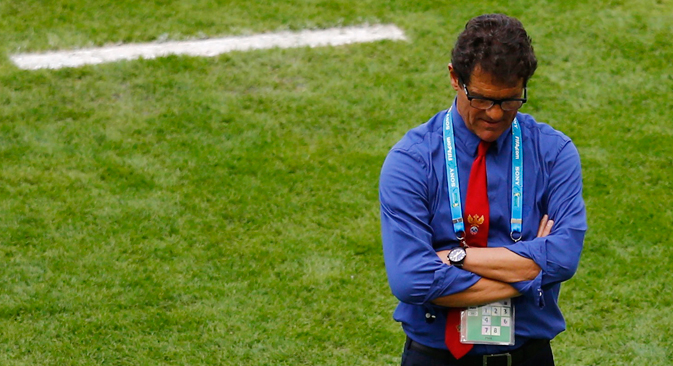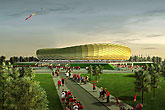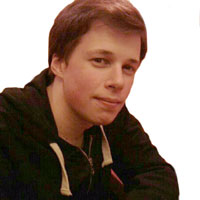Capello witch-hunt masks threadbare legacy of Russia’s missing generation

Fabio Capello. Source: Reuters
Fabio Capello started this year a hero but ends it a villain.
Back in January, the Italian coach of Russia’s national soccer team was on a high, awarded an $11 million-a-year contract extension after ensuring Russia qualified for its first World Cup in 12 years.
Now, after Russia’s last match of the year, he is vilified by press, fans and politicians, and branded a thief for his vast salary. Russia meekly exited the World Cup without a win and has won just one of its last eight competitive matches. A 2-1 win in a friendly against Hungary on Nov. 18 didn’t do much to ease the pressure – in a match they should have won easily, Russia’s players had to toil like an obese man on a treadmill.
As Russia’s winning form has evaporated, so too has Capello’s salary. The Italian has gone unpaid for the last six months, as the Russian Football Union is ensnared in a financial crisis of its own making.
All across Russia, people are blaming the team’s form on Capello, the foreign import failing to justify his astronomical price tag. While he’s certainly made tactical mistakes and plenty of them, I think the reasons for Russia’s problems go much further back. All the way back to the 1990s, in fact.
Simply put, Russia does not have enough football players with the talent to match its level of ambition and, with three and a half years to go until the country hosts the World Cup, there’s very little sign of that improving.
To understand why, consider a player who will be 28 at the 2018 World Cup, about the age a striker might be expected to hit peak form. Our man – let’s call him Ivan Ivanov, roughly the Russian equivalent of John Doe – was born in the 1990s, as the Soviet Union was collapsing and a decade of chaos, poverty and war began for Russia.
Ivan will likely have spent much his early childhood hungry or poorly nourished, perhaps eating instant noodles for weeks on end, as one of my friends remembers doing when vegetables became too expensive for her parents to buy. Unsurprisingly, instant noodles do not create champion footballers. However much talent a kid may have, poor childhood nutrition can stunt physical development and limit his potential. There’s even a persuasive argument that England’s victory at the 1966 World Cup was partly the result of Second World War rationing, when the state distribution of food actually improved the diet of many youngsters in British slums.
Our undernourished Ivan is a standout player in schoolyard football games and, when he reaches the age of 10 or 12, looks to join a major club’s academy to develop his talent. Here, however, he hits another problem. The turbulence of the 1990s ravaged Russian football clubs just as it did the wider economy. Previously state-supported clubs were fighting for survival in the market and bosses, many of them corrupt, resorted to a type of asset-stripping, selling off talented players abroad and neglecting youth development. With management changing frequently at many clubs, long-term planning was all but abandoned.
So, around 2000, our Ivan enters a renowned Russian club’s football academy, but years of neglect have left it barely functional. The facilities are decaying, the staff are underpaid and the coaching methods are decades behind those in England or Germany. Over time, the situation improves as economic stability means clubs can make long-term plans again, but the damage has been done. Poor youth coaching has leached away some more of his potential.
Fast forward to 2014 and Ivan, now 25, has broken into the Russian national team. He’s not brilliant by international standards, but he’s the best Russia has available in his position. Now there’s a new threat – complacency.
The Russian Premier League has a quota system limiting the number of foreign players a club can field, a measure designed to promote young Russian talent. Unfortunately, this often backfires. Since Russian clubs have to field Russians, they fight over them, driving up wages beyond their normal market value, so there’s little incentive for Ivan to move abroad to a top European club where he could develop his talent further. The effects of the 1990s mean there are fewer talented Russian players than usual, so anyone close to national-team level is likely to play every game for his club. No matter how badly Ivan plays, his club’s coach is unlikely to drop him – there’s simply no one else available. Complacency sets in.
Of course, this story is something of a caricature. Not every player suffers all the misfortunes of our luckless Ivan, but enough do. Russia’s national team now has a generation gap as many boys born in the early 1990s either never took up football or never developed as well as they could have done.
Capello’s Russia team relies heavily on players who spent their formative years in the Soviet Union, like 35-year-old defensive stalwart Sergei Ignashevich or 33-year-old team captain Roman Shirokov. It’ll be a miracle if either plays at the 2018 World Cup. Meanwhile, players born in the late 1990s include such promising talents that Russia won the European under-17 championship last year.
In between, there are few big names. Creative midfielder Alan Dzagoev, 24, is perhaps the best known abroad after some exciting performances early in his career, but his progress has stalled alarmingly in recent years. Striker Alexander Kokorin, 23, may well lead Russia’s attack at the 2018 World Cup, but made little impact in Brazil this summer.
The same lack of talented 90s kids has hit other countries too. The Czech Republic, Poland, Ukraine, all major football nations, have regressed in recent years. At this summer’s World Cup, Eastern Europe was represented only by Croatia and Bosnia-Herzegovina, both countries that rely heavily on players who grew up as refugees in Germany.
Still, it’s Russia that will become the World Cup’s first Eastern European host in 2018, and that gives its problems a special urgency.
Other countries have golden generations of players, but right now Russia has a missing generation, and that’s not something Capello can fix easily.
Read more: Teenage sensations: Russia’s sporting wunderkinds>>>
All rights reserved by Rossiyskaya Gazeta.
Subscribe
to our newsletter!
Get the week's best stories straight to your inbox


